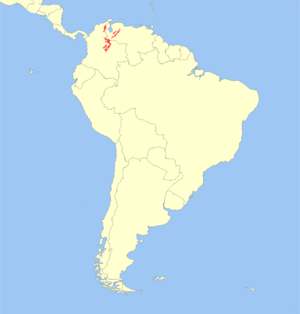Mérida brocket facts for kids
Quick facts for kids Mérida brocket |
|
|---|---|
| Conservation status | |
| Scientific classification | |
| Genus: |
Mazama
|
| Species: |
bricenii
|
 |
|
The Mérida brocket (Mazama bricenii), also called the Meroia brocket or rufous brocket, is a small type of deer. It lives in the high mountains of the Andes in northern Colombia and western Venezuela. You can find it in forests and special high-altitude grasslands called páramo, usually between 1,000 and 3,500 meters (about 3,300 to 11,500 feet) above sea level.
Scientists used to think the Mérida brocket was just a kind of the similar little red brocket. However, since 1987, most experts agree it is its own unique species.
Contents
About the Mérida Brocket
Mérida brockets are shy and mostly active at dawn and dusk. They are part of a group of deer known as brockets, which are found in Central and South America. These deer are generally small to medium-sized.
What Does a Mérida Brocket Look Like?
The Mérida brocket is a small deer with a reddish-brown coat. Its fur helps it blend in with the forest and páramo environments. Like many deer, males have small, simple antlers. These antlers are usually short and pointy, not large and branched like those of bigger deer species.
Where Do Mérida Brockets Live?
These deer are found in the northern parts of the Andes Mountains. This mountain range stretches through several South American countries. The Mérida brocket prefers areas with dense vegetation, which provides good cover from predators.
- Forests: They live in cloud forests and montane forests, which are high-altitude forests often covered in mist.
- Páramo: This is a unique ecosystem found in the Andes, above the tree line but below the permanent snow line. It's characterized by tough grasses, shrubs, and special plants adapted to cold, wet conditions.
What Do Mérida Brockets Eat?
Mérida brockets are herbivores, meaning they eat plants. Their diet mainly consists of:
- Leaves
- Twigs
- Fruits that have fallen from trees
- Fungi
They spend a lot of their time foraging for food on the forest floor or in the dense vegetation of the páramo.
How Do Mérida Brockets Live?
Mérida brockets are generally solitary animals. This means they usually live alone, except when mothers are raising their fawns. They are very secretive, which makes them hard to spot in the wild.
- Activity: They are most active during the early morning and late afternoon.
- Shelter: They use the thick undergrowth of the forest or the tall grasses of the páramo for shelter and to hide from predators.
Life Cycle and Reproduction
Like other deer, Mérida brockets reproduce by giving birth to live young. A baby deer is called a fawn.
- Gestation: The mother carries the fawn for several months before giving birth.
- Fawns: Fawns are born with spotted coats, which help them camouflage among the dappled light of the forest. They stay hidden while their mothers forage for food.
- Growth: Fawns grow quickly, and the mother protects them until they are old enough to live on their own.
Conservation Status
The Mérida brocket is listed as Vulnerable (VU) by the International Union for Conservation of Nature (IUCN). This means that the species faces a high risk of becoming endangered in the wild.
- Threats: The main threats to the Mérida brocket include:
- Habitat loss: Forests and páramo areas are being cleared for farming, cattle grazing, and human settlements.
- Hunting: They are sometimes hunted for their meat.
- Conservation Efforts: Protecting their habitat and reducing illegal hunting are important steps to help these unique deer survive.
See also
 In Spanish: Corzuela de Mérida para niños
In Spanish: Corzuela de Mérida para niños


